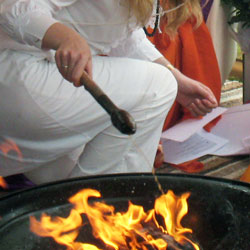- About
Background to Vedic Ceremonies


 The religious ceremonies from India are the oldest existing functional spiritual ceremonies in the world. Although the beginnings are shrouded in the mists of time, we can trace them back to approximately 8,000 BC, although the Brahmin priests say they are much older.These ceremonies are almost always linked to a “deity,” causing a view of Hinduism as pantheistic. However, the idea of pantheism is inaccurate. In the spiritual context of the broad intellectual understanding of creation, as put forth in the oldest scriptures, God or Truth is infinite and unitary. Truth is one. Thus, the various gods and goddesses are explained in one of two ways:They are beings who have realized Truth and embody some profound principle within that Truth. In this context, they are not much different from the Saints of the Catholic Church, or the ancestors of China.They are principles or aspects of divine power, which are anthropomorphized or personified for purposes of the understanding of and relating to these principles. What matters most is the depth and extent of the divine experience such religious ceremonies invoke in those who attend.
The religious ceremonies from India are the oldest existing functional spiritual ceremonies in the world. Although the beginnings are shrouded in the mists of time, we can trace them back to approximately 8,000 BC, although the Brahmin priests say they are much older.These ceremonies are almost always linked to a “deity,” causing a view of Hinduism as pantheistic. However, the idea of pantheism is inaccurate. In the spiritual context of the broad intellectual understanding of creation, as put forth in the oldest scriptures, God or Truth is infinite and unitary. Truth is one. Thus, the various gods and goddesses are explained in one of two ways:They are beings who have realized Truth and embody some profound principle within that Truth. In this context, they are not much different from the Saints of the Catholic Church, or the ancestors of China.They are principles or aspects of divine power, which are anthropomorphized or personified for purposes of the understanding of and relating to these principles. What matters most is the depth and extent of the divine experience such religious ceremonies invoke in those who attend.Purpose of The Ceremonies
Pujas are undertaken as a form of asking the Divine for help and guidance, for seeking true spiritual advancement and for expressing gratitude.Effects of Ceremonies
These ceremonies take the power of the Sanskrit mantras being chanted and drive them through the nerve tubes (“nadis” in Sanskrit) of the subtle body, clearing accumulated karmic debris which has sometimes been stored there for many lifetimes.



Tell a friend 



Saraswati Publications, LLC | 3300 NW 185th Avenue, #92 | Portland | OR | 97229 | © 2012 | Privacy Notice
